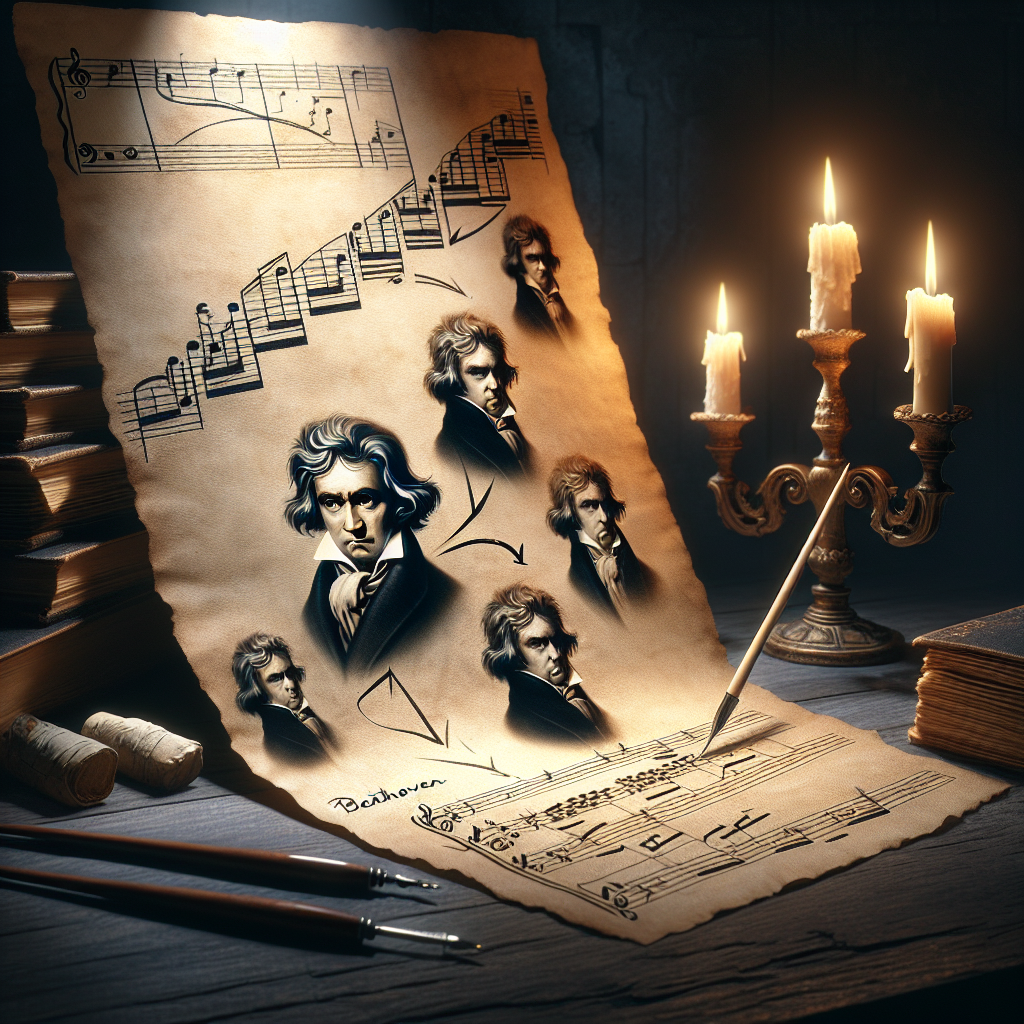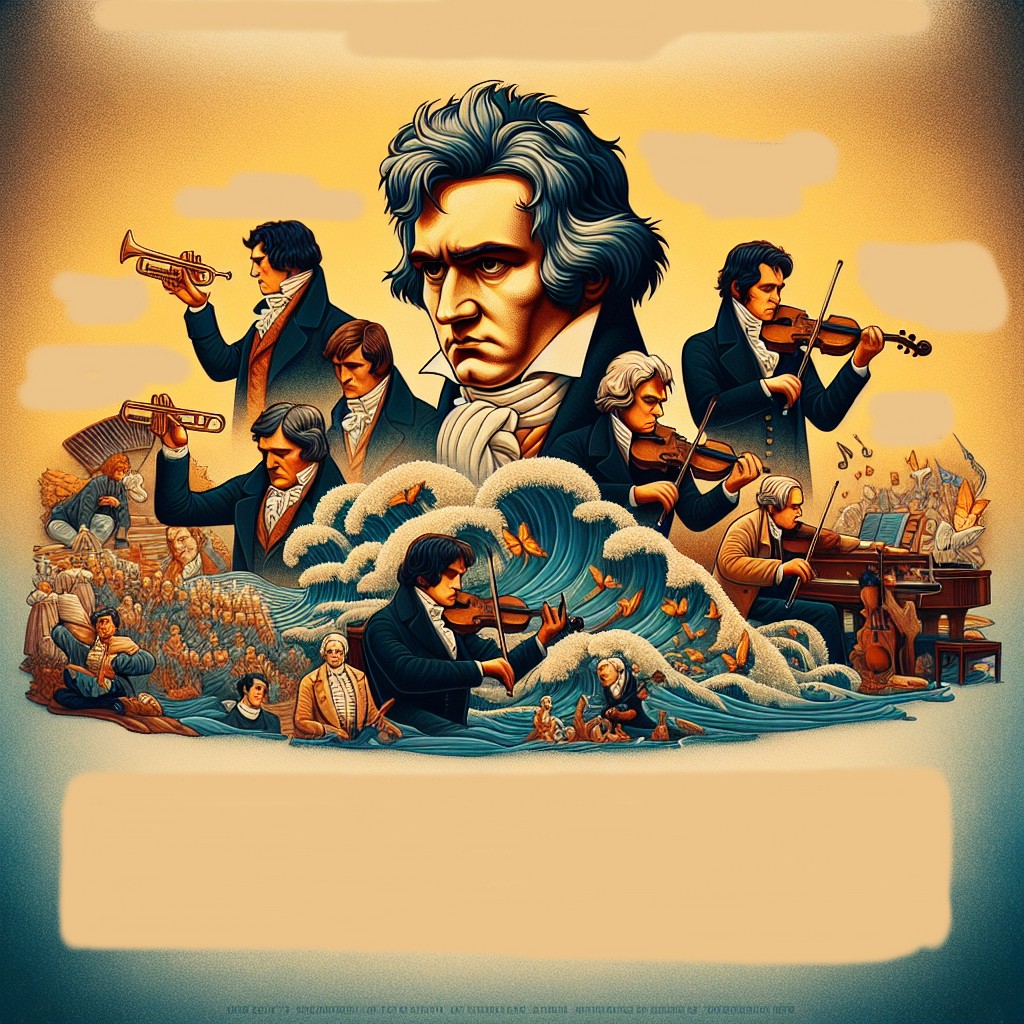
The Evolution of Beethoven’s Early Musical Style
Ludwig van Beethoven, one of the most lauded composers in the classical music realm, embarked on his musical journey at a very young age. Born in Bonn, Germany in 1770, Beethoven’s prodigious talent was recognized early by his father Johann, who sought to mold him into the next Mozart. Despite a tumultuous childhood, the scaffolding for his profound influence on classical music was constructed during these formative years.
Beethoven’s early works reflect the raw and unpolished beginnings of his genius. Fueled by rigorous training, these compositions were primarily created for performance in the salons and courts of Europe. His ability to meld passion with technical prowess began to emerge and evolve during this period.
Central to understanding Beethoven’s early musical style is the way he balanced his composition with the piano, demonstrating both exceptional technical ability and deep emotional expression. This period marks the nascent stages of Beethoven’s exploration of harmonic structures and dynamic contrasts, which would later define his style and influence.
It’s not only the published works that offer a glimpse into Beethoven’s early years, but also unpublished pieces that reveal his exploratory nature. These compositions, though less polished, provide significant insights into his developmental processes and serve as a testament to his evolving artistry during his youth.
Exploring Beethoven’s Early Works
Beethoven’s early works exhibit a blend of classical styles, deriving inspiration from the likes of Haydn and Mozart, yet still hint at the innovative spirit that would later come to full fruition. Pieces such as his first symphony in C major and the Septet in E-flat major demonstrate his grasp over contrasting motifs and orchestral balance.
The early piano sonatas and trios also serve as a portal into his evolving style. Beethoven’s Opus 2, consisting of three piano sonatas, showcases his ability to infuse robust expression into traditional forms. These compositions reveal the foundational elements of what would become Beethoven’s unique musical voice.
The influence of Baroque and early Classical traditions is evident in these pieces, but Beethoven’s manipulation of tempo, use of rhythmic variation, and integration of unexpected dynamics set his work apart. Many of these compositions were created for private performances, highlighting their intimate and exploratory nature.
This period marked a transition for Beethoven, as he started gaining recognition not only as a virtuoso pianist but also as an innovative composer. These early works illustrate his journey from perfecting classical forms to beginning to break them, setting the stage for his more daring and revolutionary pieces.
Unpublished Works: A Peek Into Beethoven’s Creative Process
Beethoven’s unpublished works bring an additional layer of understanding to his early years. These compositions, often drafts or incomplete pieces, show his rigorous approach to experimentation and development. They serve as windows into his creative process, revealing the meticulous and iterative nature of his work.
Sketchbooks filled with musical ideas and incomplete compositions tell us about the parameters within which Beethoven worked and explored. These works often show a side of Beethoven that was more freeform, untethered from the constraints of public performance expectations and formal publishing standards.
For example, several unpublished piano pieces from his early years exhibit Beethoven’s struggle with mastering and experimenting within the bounds of classical precedents. His variations on themes, attempts at fusing different forms, and escalation of technical complexity reveal a composer in constant dialogue with tradition and innovation.
By studying these unpublished works, historians and musicians gain insight into Beethoven’s day-to-day engagement with music, from the mundane to the magnificent. These pieces provide a mosaic of his growth and persistence, underscoring the laborious and often nonlinear nature of artistic mastery.

Influence of Teachers and Contemporaries
Beethoven’s early career was significantly shaped by his interactions with contemporary composers and mentors. One of the most influential was Joseph Haydn, whom he studied with during his early years in Vienna. Haydn’s symphonic and chamber works influenced Beethoven’s early compositions profoundly, although their relationship was not always harmonious.
Another pivotal figure in Beethoven’s life was Johann Albrechtsberger, a renowned theorist and composer. Under his tutelage, Beethoven honed his counterpoint skills, which became a critical component of his compositional style. These lessons were invaluable, reinforcing the structural and technical facets of Beethoven’s music.
Beethoven’s contemporaries, like Mozart and Clementi, also left an indelible mark on his style. Beethoven admired Mozart deeply, and their encounter in Vienna reportedly left a lasting impression on the young composer. His sonatas and concertos bear traces of Mozart’s influence, albeit imbued with his emerging distinctiveness.
Beethoven’s interactions with these figures provided him with a rich tapestry of techniques and perspectives, all of which he absorbed and transformed in his unique way. The early works thus can be seen not only as individual accomplishments but also as dialogues with the broader musical traditions of the time.
Key Compositions from Early Period
Among Beethoven’s early compositions are several notable works that stand out for their complexity and emotional depth. His first symphony, Symphony No. 1 in C major, is a prime example. Published in 1800, it adheres to classical symphonic form while hinting at the innovation that would characterize his later work.
The Piano Sonatas No. 5 and No. 6 in F minor and D respectively, also showcase his evolving style. These pieces blend technical brilliance with expressive range, demonstrating his ability to push the boundaries of the sonata form. Each sonata reflects Beethoven’s ability to communicate profound emotion through intricate musical structures.
Another significant early work is the Septet in E-flat Major, Op. 20, which became immensely popular during Beethoven’s lifetime. This composition exhibits an intricate interplay between different instruments, showcasing Beethoven’s knack for orchestral texture and thematic development.
These compositions mark the culmination of his early period, reflecting a mastery of classical forms while signaling the innovative impulses that would dominate his later work. They are essential in understanding the trajectory of Beethoven’s artistic evolution.
Innovation and Evolution: The Early Style
Beethoven’s early works are characterized by a bold interaction with and departure from the classical norms of his predecessors. While firmly rooted in tradition, he began to introduce elements that would define his mature style: dramatic contrasts, expanded harmonic language, and innovative structural designs.
His early innovation can be seen in his approach to rhythm and dynamics. Beethoven frequently employed sudden shifts in volume and tempo, creating a sense of urgency and vitality in his music. This was a marked deviation from the more restrained dynamics of earlier classical composers.
Additionally, Beethoven’s use of harmony began to expand during this period. He started experimenting with chromaticism and modulations, adding depth and complexity to his harmonic progressions. This experimentation laid the groundwork for the more advanced harmonic explorations in his middle and late periods.
Thematically, Beethoven’s early works often conveyed a sense of struggle and triumph, emotions that were deeply personal and yet universally relatable. This thematic focus would persist throughout his career, making his music resonate with audiences across different eras and cultures.
Conclusion: Beethoven’s Enduring Legacy
Ludwig van Beethoven’s early works form an essential chapter in the story of Western classical music. These compositions, with their blend of classical rigor and burgeoning innovation, not only showcase his prodigious talent but also set the stage for his revolutionary contributions to music.
Through his early works, we observe the foundations of his later masterpieces. The tension between tradition and innovation, the emotional depth, and the technical brilliance evident in these pieces foretell the groundbreaking nature of his subsequent works. Beethoven’s early period is a testament to his relentless pursuit of artistic excellence and his unwavering commitment to musical exploration.
Today, scholars and musicians continue to study these early compositions, gaining insights into his creative development and the broader historical context in which he worked. His early music remains a source of inspiration and admiration, underscoring the timeless appeal of his genius.
As we celebrate and study Beethoven’s legacy, his early works remind us of the importance of understanding the journey of an artist’s evolution. They highlight the significance of every stage in the creative process and the enduring impact of a true master of his craft.